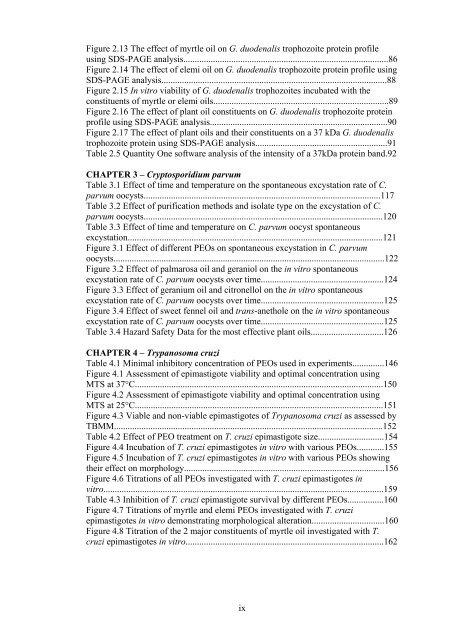the inhibitory properties of and mode of action of plant essential oils ...
the inhibitory properties of and mode of action of plant essential oils ...
the inhibitory properties of and mode of action of plant essential oils ...
You also want an ePaper? Increase the reach of your titles
YUMPU automatically turns print PDFs into web optimized ePapers that Google loves.
Figure 2.13 The effect <strong>of</strong> myrtle oil on G. duodenalis trophozoite protein pr<strong>of</strong>ile<br />
using SDS-PAGE analysis..........................................................................................86<br />
Figure 2.14 The effect <strong>of</strong> elemi oil on G. duodenalis trophozoite protein pr<strong>of</strong>ile using<br />
SDS-PAGE analysis...................................................................................................88<br />
Figure 2.15 In vitro viability <strong>of</strong> G. duodenalis trophozoites incubated with <strong>the</strong><br />
constituents <strong>of</strong> myrtle or elemi <strong>oils</strong>.............................................................................89<br />
Figure 2.16 The effect <strong>of</strong> <strong>plant</strong> oil constituents on G. duodenalis trophozoite protein<br />
pr<strong>of</strong>ile using SDS-PAGE analysis..............................................................................90<br />
Figure 2.17 The effect <strong>of</strong> <strong>plant</strong> <strong>oils</strong> <strong>and</strong> <strong>the</strong>ir constituents on a 37 kDa G. duodenalis<br />
trophozoite protein using SDS-PAGE analysis..........................................................91<br />
Table 2.5 Quantity One s<strong>of</strong>tware analysis <strong>of</strong> <strong>the</strong> intensity <strong>of</strong> a 37kDa protein b<strong>and</strong>.92<br />
CHAPTER 3 – Cryptosporidium parvum<br />
Table 3.1 Effect <strong>of</strong> time <strong>and</strong> temperature on <strong>the</strong> spontaneous excystation rate <strong>of</strong> C.<br />
parvum oocysts........................................................................................................117<br />
Table 3.2 Effect <strong>of</strong> purification methods <strong>and</strong> isolate type on <strong>the</strong> excystation <strong>of</strong> C.<br />
parvum oocysts.........................................................................................................120<br />
Table 3.3 Effect <strong>of</strong> time <strong>and</strong> temperature on C. parvum oocyst spontaneous<br />
excystation................................................................................................................121<br />
Figure 3.1 Effect <strong>of</strong> different PEOs on spontaneous excystation in C. parvum<br />
oocysts.......................................................................................................................122<br />
Figure 3.2 Effect <strong>of</strong> palmarosa oil <strong>and</strong> geraniol on <strong>the</strong> in vitro spontaneous<br />
excystation rate <strong>of</strong> C. parvum oocysts over time......................................................124<br />
Figure 3.3 Effect <strong>of</strong> geranium oil <strong>and</strong> citronellol on <strong>the</strong> in vitro spontaneous<br />
excystation rate <strong>of</strong> C. parvum oocysts over time......................................................125<br />
Figure 3.4 Effect <strong>of</strong> sweet fennel oil <strong>and</strong> trans-anethole on <strong>the</strong> in vitro spontaneous<br />
excystation rate <strong>of</strong> C. parvum oocysts over time......................................................125<br />
Table 3.4 Hazard Safety Data for <strong>the</strong> most effective <strong>plant</strong> <strong>oils</strong>................................126<br />
CHAPTER 4 – Trypanosoma cruzi<br />
Table 4.1 Minimal <strong>inhibitory</strong> concentration <strong>of</strong> PEOs used in experiments..............146<br />
Figure 4.1 Assessment <strong>of</strong> epimastigote viability <strong>and</strong> optimal concentration using<br />
MTS at 37°C.............................................................................................................150<br />
Figure 4.2 Assessment <strong>of</strong> epimastigote viability <strong>and</strong> optimal concentration using<br />
MTS at 25°C.............................................................................................................151<br />
Figure 4.3 Viable <strong>and</strong> non-viable epimastigotes <strong>of</strong> Trypanosoma cruzi as assessed by<br />
TBMM......................................................................................................................152<br />
Table 4.2 Effect <strong>of</strong> PEO treatment on T. cruzi epimastigote size.............................154<br />
Figure 4.4 Incubation <strong>of</strong> T. cruzi epimastigotes in vitro with various PEOs............155<br />
Figure 4.5 Incubation <strong>of</strong> T. cruzi epimastigotes in vitro with various PEOs showing<br />
<strong>the</strong>ir effect on morphology........................................................................................156<br />
Figure 4.6 Titrations <strong>of</strong> all PEOs investigated with T. cruzi epimastigotes in<br />
vitro...........................................................................................................................159<br />
Table 4.3 Inhibition <strong>of</strong> T. cruzi epimastigote survival by different PEOs................160<br />
Figure 4.7 Titrations <strong>of</strong> myrtle <strong>and</strong> elemi PEOs investigated with T. cruzi<br />
epimastigotes in vitro demonstrating morphological alteration................................160<br />
Figure 4.8 Titration <strong>of</strong> <strong>the</strong> 2 major constituents <strong>of</strong> myrtle oil investigated with T.<br />
cruzi epimastigotes in vitro.......................................................................................162<br />
ix




